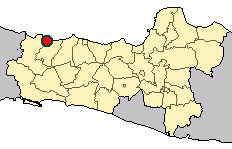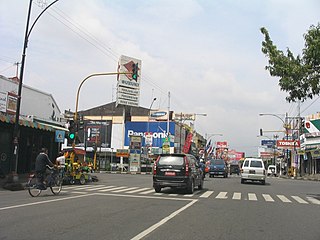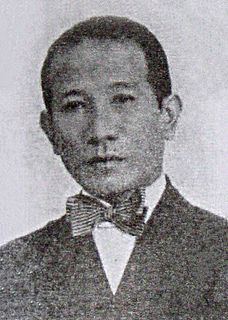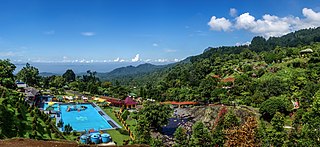
Central Java is a province of Indonesia, located in the middle of the island of Java. Its administrative capital is Semarang. It is bordered by West Java in the west, the Indian Ocean and the Special Region of Yogyakarta in the south, East Java in the east, and the Java Sea in the north. It has a total area of 32,548 km², with a population of 34,552,500 million in mid 2019, making it the third-most populous province in both Java and Indonesia after West Java and East Java. The province also includes the island of Nusakambangan in the south, and the Karimun Jawa Islands in the Java Sea. Central Java is also a cultural concept that includes the Special Region and city of Yogyakarta. However, administratively the city and its surrounding regencies have formed a separate special region since the country's independence, and is administrated separately. Although known as the "heart" of Javanese culture, there are several other non-Javanese ethnic groups, such as the Sundanese on the border with West Java. Chinese Indonesians, Arab Indonesians, and Indian Indonesians are also scattered throughout the province.

Kelud is an active stratovolcano located in East Java, Indonesia. Like many Indonesian volcanoes and others on the Pacific Ring of Fire, Kelud is known for large explosive eruptions throughout its history. More than 30 eruptions have occurred since 1000 AD. In 2007, an effusive explosion filled the crater with a lava dome. It last erupted on February 13, 2014, destroying the lava dome and ejecting boulders, stones and ashes up to West Java about 500 kilometers from Mount Kelud. The crater filled with water during the rainy season.

Banyumas Regency is a regency in the southwestern part of Central Java province in Indonesia. Its capital is the town of Purwokerto. It covers an area of 1,335.30 km2, and had a population of 1,554,527 at the 2010 Census; the latest estimate is 1,573,593.

Tegal is a large city in the northwest part of Central Java Province of Indonesia. It is situated on the north coast of Central Java, about 175 kilometres (109 mi) from Semarang, the capital of the province. It had a population of 239,599 at the 2010 Census, but the latest official estimate is 242,539. Its built-up area made of Tegal Municipality and 12 districts spread on Tegal and Bremes regencies was home to 1,366,858 inhabitants as of 2010 census. It is administratively separate from Tegal Regency, which borders it to the south and east; Brebes Regency borders it to the west.

Purwokerto is a non-autonomous town on the island of Java, Indonesia. It is the capital of Banyumas Regency, Central Java region. The population of the town at the 2010 Census was 233,951

Indra Lesmana is an Indonesian jazz musician.
Mas Penewu Surakso Hargo, better known as Mbah Maridjan was the spiritual guardian or "gatekeeper" of the Indonesian volcano Mount Merapi. His birthplace was in the mountainside hamlet of Kinahrejo, Umbulharjo Village, Cangkringan District, of the Sleman Regency, on the island of Java in Indonesia.

Tegal Regency is one of the regencies in the northwest part of Central Java province of Indonesia, with an area of 876.1 km2 (338.3 sq mi). The administrative center used to be in Tegal City, in the northwest corner of the regency, but then Tegal City was administratively separated from the regency and formed into its own territory. The city was later replaced as the administrative center of Tegal Regency by Slawi Town, which is a suburb about 20 km (12 mi) to the south of the city and within the district boundary.

Mr. Kangjeng Raden Tumenggung Wongsonegoro served as Minister of the Interior, Minister of Justice, and Minister of Education and Culture of Indonesia. He was also Deputy Prime Minister during the First Ali Sastroamidjojo Cabinet.

Major General Professor Moestopo was an Indonesian dentist, freedom fighter, and educator. He was declared a National Hero of Indonesia on 10 November 2007.

Brigadier General Ignatius Slamet Rijadi was an Indonesian soldier.

The State of Pasundan was a federal state (negara bagian) formed in the western part of the Indonesian island of Java by the Netherlands in 1948 as part of an attempt to reestablish the colony of the Dutch East Indies during the Indonesian National Revolution. It was similar to the geographical area now encompassed by the current provinces of West Java, Banten and Jakarta.

Abisin Abbas, better known by his pseudonym Andjar Asmara, was a dramatist and filmmaker active in the cinema of the Dutch East Indies. Born in Alahan Panjang, West Sumatra, he first worked as a reporter in Batavia. He became a writer for the Padangsche Opera in Padang, where he developed a new, dialogue-centric style, which later spread throughout the region. After returning to Batavia in 1929, he spent over a year as a theatre and film critic. In 1930 he joined the Dardanella touring troupe as a writer. He went to India in an unsuccessful bid to film his stage play Dr Samsi.

Srigala Item is a 1941 film from the Dutch East Indies that was directed by Tan Tjoei Hock and produced by The Teng Chun for Action Film. Starring Hadidjah, Mohamad Mochtar, and Tan Tjeng Bok, the film's plot – inspired by Zorro – follows a young man who became a masked vigilante to take revenge against his conniving uncle. Srigala Item was a commercial success, which Misbach Yusa Biran credits to the plot's use for escapism. A copy of the black-and-white film, which featured kroncong music, is stored at Sinematek Indonesia.
Noesa Penida is a 1941 film from the Dutch East Indies which was directed by Andjar Asmara and produced by The Teng Chun of Java Industrial FIlm. It tells of a love triangle between two brothers, born to a commoner, and a noble woman.

Si Gomar is a 1941 film from the Dutch East Indies which was written and directed by Tan Tjoei Hock and produced by The Teng Chun. Starring Hadidjah, Mohamad Mochtar, and Tan Tjeng Bok, the movie follows a brother and sister who are separated by robbers and almost marry before their cousin recognises them.

Soerip was an Indonesian singer and film actress.

Baturraden is a district in the Banyumas Regency on the slope of Mount Slamet, Central Java. It features panoramic views, waterfalls, a mini-train, paddleboats, a water slide, and a pool. Its name is derived from a legend about star-crossed lovers, a manservant (Batur) and noblewoman (Raden).

Saka Tunggal Mosque is a mosque located in Cikakak, Banyumas, Central Java. Established in 1871, it is considered a Cultural Property of Indonesia. The complex is home to thousands of monkeys.

Bambang Soegeng was an Indonesian military officer and diplomat. He was the Chief of Staff of the Indonesian Army between 1952 and 1955, and later served in ambassadorial offices to the Holy See, Japan, and Brazil.




















